- Luang Prabang Tours
- Manifa Elephant Camp
- Manifa Elephant Camp
- Visitor Packages
- Manifa Elephant Camp’s 6 Key Concepts
- The ethics of elephant tourism from Donna Haraway’s perspective
- Elephant FAQs
- Half Day Elephant Mahout Experience
- 1 Day Elephant Mahout Experience
- 1 Day Combo Elephant Mahout Experience
- Manifa Elephant Camp Cottages Accommodation / Resort Packages
- Laos Private Multi-day Tour
- Information
Mekong River Cruise
Mekong River Cruise – Luang Prabang Day Trip
Taking a boat trip is probably one of the most rewarding ways to discover the local life along the rivers. The heritage city Luang Prabang is built on the confluence of the Mekong and the Nam Khan rivers. The Mekong River has been the main highways for people and goods for centuries and is still seamlessly integrated into the lifestyle of the people of Luang Prabang. Fishers fish in the morning and evening, and women dip their feet in the water to catch river shrimp. Children splash in the river on summer afternoons. In the dry season, fertile land along the riverside (the Mekong’s water level can rise and fall nearly 10 meters) is used for farming and for grazing buffalo.
Upstream, there is mysterious Pak Ou Caves lined with countless Buddha statues. Located in limestone cliffs 25 kilometres upriver from Luang Prabang, the caves are said to have been discovered by King Setthathirat (r. 1520-48) in the 16th century, after the construction of Wat Pak Ou, on the other bank of the river at Ban Pak Ou, but they were possibly centres of spirit worship prior to this time. The king visited every New Year, and would have stayed on the other bank of the Mekong, at Ban Pak Ou. Francis Garnier, the French explorer, visited the caves on his travels when he charted the Mekong river in the 1860s.
Both the upper and lower limestone cliffs have caves, connected by steep steps, and filled with Buddhas statues. This is a place of pilgrimage, a numinous journey, and pilgrims have come here for centuries. They believe that phi, the spirits of the rivers and cave, dwell here.
The caves are set high in a cliff that rises vertically from the Mekong river, and they are reached by a series of steep steps. There are two levels, and the caves are called, respectively, Tham Thing and the upper ones Tham Phum. The higher ones are some 60 metres above the river. The lower cave is the focal point for most visitors. Offerings of flowers and incense are made here, and local villagers sell these on the steps going up. Images of lions guard the entrance to the caves.
At New Year crowds of people flock to the caves by boat from Luang Prabang. Inside there are thousands of historic Buddha statues, brought by pilgrims over the centuries. Most date from the 18th and 19th centuries. The older ones, covered with dust, are of wood, predominantly in the style of the Buddha Calling for Rain, but also a variety of other poses, including Calling the Earth to Witness and Meditation mudras. Some are tiny, a few centimetres high, while others are much taller. Lacquered and gilded, many are dilapidated, but their dust-covered appearance, all crammed together in the caves, makes for a haunting atmosphere that lingers in the memory. Official figures placed the number of images in the region of 4,000, and they used to fill every shelf and crevice of the caves. Unfortunately many have been stolen and are increasingly being replaced by modern plaster ones.
Related Tours
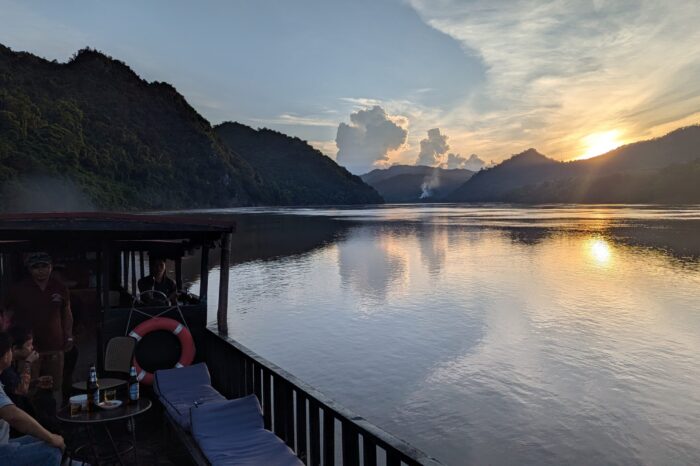
EUR22
Afternoon Kuang Si Waterfalls & Sunset Cruise (H04)
Discover the Kuang Si Waterfalls and enjoy a sunset cruise on the Mekong River. Swim in the turquoise pools, explore forest trails, and relax with a drink on the cruise.
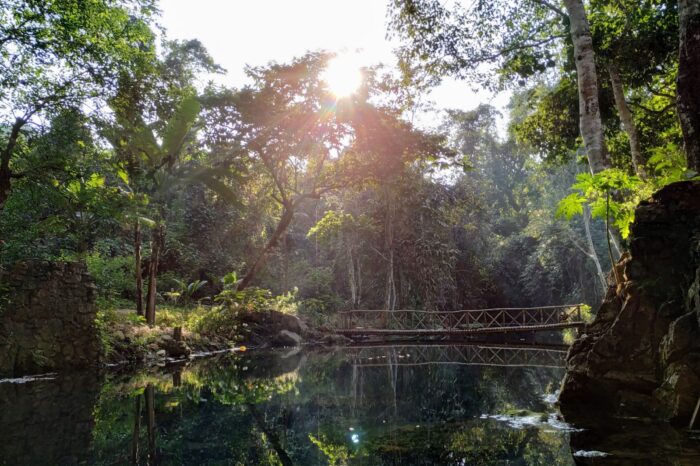
New
EUR28
Kuang Si Waterfalls Forest Easy Hike & Mekong Sunset Cruise (F18)
Cruise the Mekong River and hike a secluded forest trail to Kuang Si's source. Enjoy lunch at a hidden Khmu restaurant by a natural spring, swim in turquoise pools, visit a heritage rice farm, and …
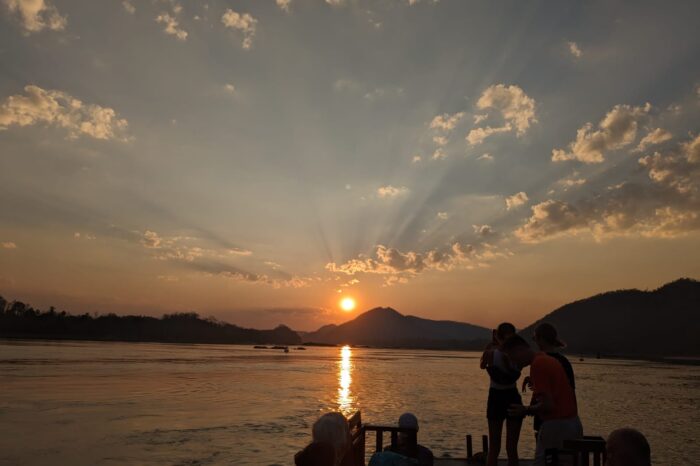
EUR40
Nong Khiaw to Luang Prabang, Mekong & Nam Ou River Cruise (NK-2)
1-day cruise tour starting in Nong Khiao and ending in Luang Prabang. Rather than driving directly, taking an old-fashioned boat trip along the Nam Ou and Mekong Rivers, visiting a cave and village.

EUR78
2 Days the most epic places and experiences in Luang Prabang (M05)
Visit most exciting attractions in Luang Prabang: World Heritage site Royal Palace and temples, Buddhist alms-giving and morning market, elephant experience or cycling, Kuang Si Falls, Mekong River cruise, Pak Ou Caves
2 days

EUR42
Cycling & Mekong Sunset Cruise, Pak Ou Caves (F28)
Joint tour: 2 or more participants required. Please contact us for 1 person Cycling and Mekong cruise More than 70% flat paved roads suitable for cycling beginners and families. Cycling with Trek Marlin7 Bikes available in …

EUR45
Luang Prabang World Heritage, Pak Ou Caves, Mekong River Sunset Cruise (F24)
This full-day tour combines a Luang Prabang city tour with an afternoon Mekong cruise to Pak Ou Caves. In the morning, you will visit various temples and royal palaces and learn about Lao history culture …

EUR115
2-Day Manifa Elephant Camp Memorable Overnight Experience (C01)
2-day elephant experience staying in a private cottage at Manifa Elephant Camp. Experience, accommodation, three meals, transportation from/to Luang Prabang included
2 days

EUR175
3-Day Manifa Elephant Camp Immersion Overnight Experience (C02)
3-day elephant experience staying in a private cottage at Manifa Elephant Camp. Experience, accommodation, three meals, transportation from/to Luang Prabang included
3 days
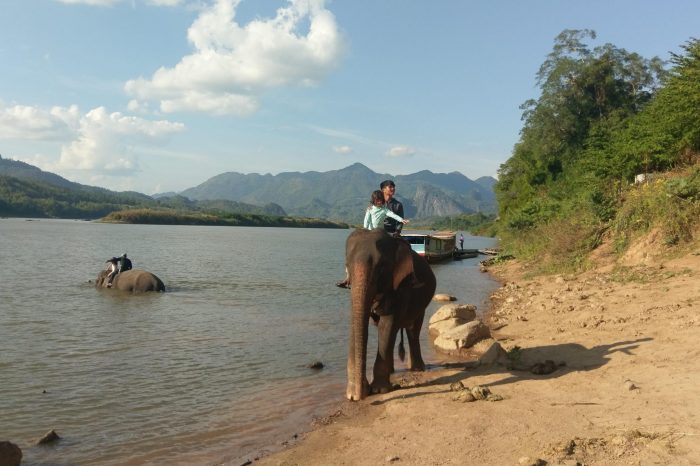
EUR89
2-Day Family Overnight Elephant Mahout Experience
Discount for families on 2-day elephant experience. Four people share two elepDiscount for families on 2-day elephant experience. 4 people share 2 elephants instead of four.hants instead of 4.
2 days

EUR22
Luang Prabang: Afternoon Kuang Si Waterfalls & Sunset Cruise (H04)
Discover the Kuang Si Waterfalls and enjoy a sunset cruise on the Mekong River. Swim in the turquoise pools, explore forest trails, and relax with a drink on the cruise

Popular
EUR40
Kuang Si Waterfalls, Mekong Sunset Cruise, Pak Ou Caves (F17-2)
Departure: Luang Prabang, Activity: Kuang Si Waterfalls, Mekong sunset cruise, Whisky village, Hmong village, Lunch at Manifa Elephant Camp

EUR45
Cycling & Kayak to Pak Ou Caves, Sunset Cruise (F21)
Take a two-wheeled adventure going out of Luang Prabang city. Pedal on the road along the Mekong river trails to the temples and villages, rice paddies. In the afternoon, enjoy kayaking in the majestic nature …

EUR31
Mekong Cruise & Pak Ou Caves (H01)
Departure: Luang Prabang Activity 1/2 day Mekong River Cruise (morning or afternoon), Pak Ou Cave, Whisky Village

Popular
EUR38
Mekong Morning Cruise, Pak Ou Caves, Kuang Si Waterfalls (F17-1)
Departure: Luang Prabang, Activity: Kuang Si Waterfalls, Mekong morning cruise, Whisky village, Hmong village, Lunch at Manifa Elephant Camp

EUR42
Kayak to Pak Ou Caves & Sunset Cruise the Mekong River (F14)
Departure: Luang Prabang Activity: Kayak, Pak Ou Caves, Mekong Sunset Cruise

Popular
EUR33
Kuang Si Falls, Khmu Village Trek & Sunset Cruise (F11)
Go beyond Kuang Si's turquoise pools. Trek through villages and rice paddies sustained by ancient waterways. End your authentic Lao day with a stunning sunset cruise on the Mekong
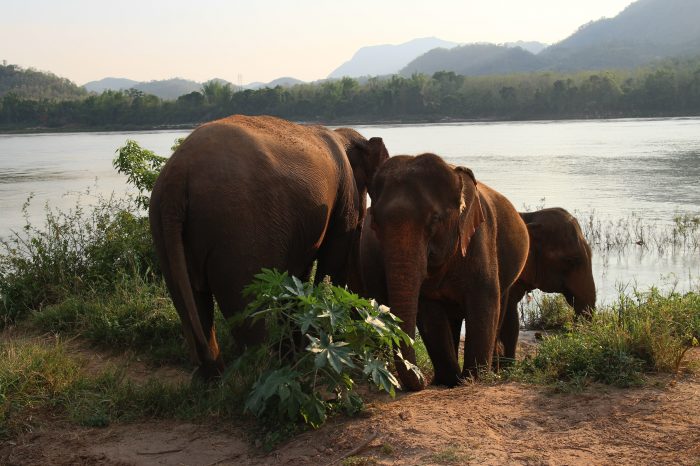
EUR42
Full-Day Glimpse Elephant Mahout Experience, Pak Ou Caves, Sunset Mekong Cruise (F10)
Experience elephants in the morning. After lunch, visit Pak Ou Caves and Whiskey Village by boat. Return to Luang Prabang by sunset cruise.
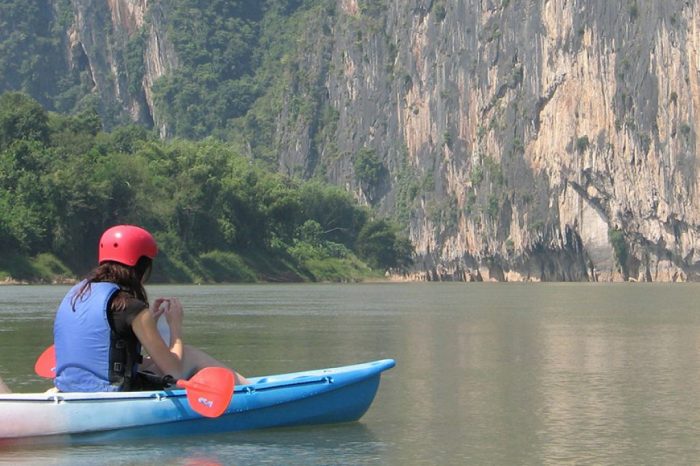
EUR42
Full-Day Glimpse Elephant Mahout Experience, Kayay to Pak Ou Caves & Sunset Mekong Cruise (F04)
Half day elephant experience, half day kayaking, two hour sunset cruise from Elephant Camp to Luang Prabang in the evening
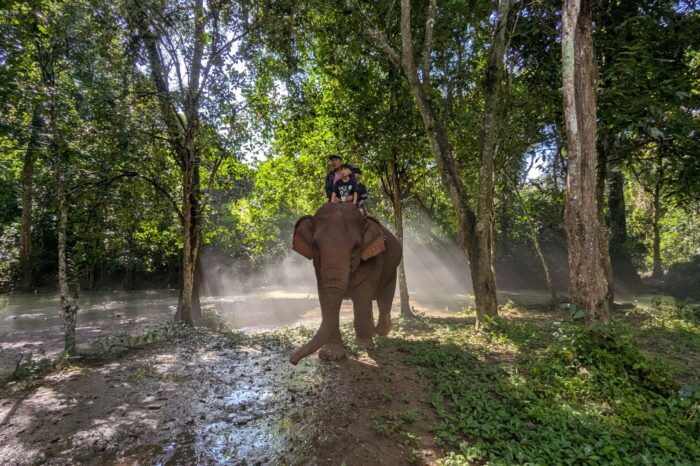
New
EUR50
Full-Day Kuang Si Falls, Elephant Walk & Mekong Sunset Cruise (F03)
Go beyond mere sightseeing on this full-day immersion into the living ecosystem of Laos. This intimate, small-group tour traces the path of water from the stunning turquoise pools of Kuang Si Waterfalls to the timeless …
-
© 2008-2025 MANIFA Group Sole Co.,Ltd
© Manifa Travel. Terms & conditions



